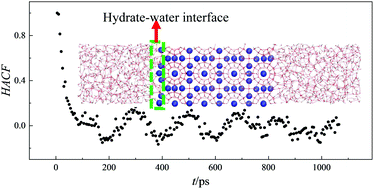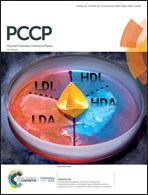Fluctuation–dissipation analysis of nonequilibrium thermal transport at the hydrate dissociation interface†
Abstract
Herein, a nonequilibrium molecular-dynamics simulation in an NVE ensemble was performed to investigate the spontaneous dissociation of methane-hydrate when it came in contact with liquid water. The nonequilibrium in the interface region is linked to the dissociation process of the hydrate near the interface according to the Onsager's hypothesis. The simulated thickness of the interface was found to be close to the acoustic phonon mean path of methane hydrate and agreed with the reference value. The normalized heat flow autocorrelation function was introduced to study fluctuation–dissipation in terms of the thickness and moving velocity of the interface and the Stefan number. This helped to clearly identify three distinct hydrate-decomposition regimes dominated by sensible heat, latent heat and an intrinsically unstable lattice framework. It was found that the fluctuation–dissipation theory could express the nonequilibrium nature in the front two stages before the threshold was reached, and the dissociation rate increased in the latter stage; this was different from the case of thermal-driven dissociation. The Stefan number decreased rapidly with dissociation in the initial stage and then fluctuated in the intermediate stage; this was analogous to the fluctuation characteristics of the heat flow autocorrelation function. The Stefan number effect shows that thermal dissipation drives the hydrate dissociation and correlates fluctuation to the nonequilibrium nature. It was also found that a small Stefan number was enough to break up the residual hydrate soon after the threshold was achieved. The transient interfacial thermal resistance of the interfacial region was obtained as a typical value in the range of 10−7–10−9 m2 K W−1. This justifies that fluctuation–dissipation exists in the nonequilibrium process of hydrate dissociation either in terms of heat flux, as observed in this study, or the diffusion of guest molecules, as reported in other studies.



 Please wait while we load your content...
Please wait while we load your content...